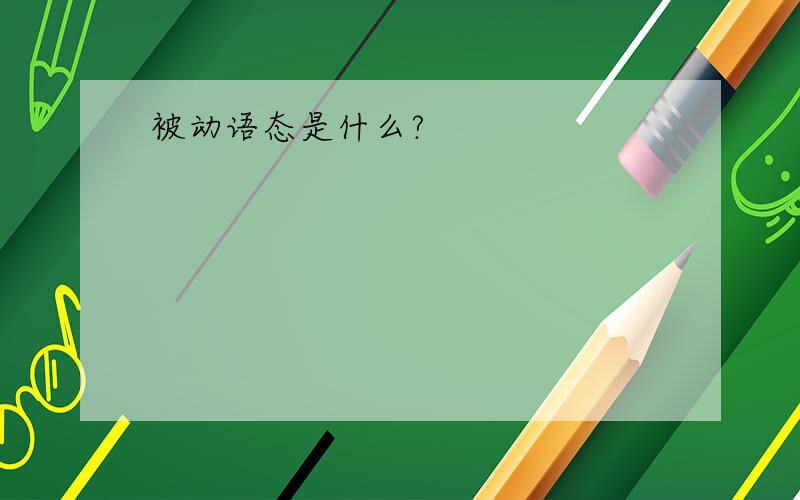被动语态是什么?
来源:学生作业帮助网 编辑:作业帮 时间:2024/11/18 18:36:37

被动语态是什么?
被动语态是什么?
被动语态是什么?
把动作的对象作句子的主语,那动词就要换一种方式来表达,如:
I did the homework yesterday.
I 为主语did 为谓语动词the homework 为 did 的对象,叫宾语.我们把 the homework 作主语,did就得换一种方式来表达,变成be done( do的过去分词),然后原句时态为过去时,be也用过去时,再把动作的发出者用by连接,形成这样的句子:
The homework was done by me yesterday.by me 可以省,因为本句不强调动作发出者.
A.主动语态中主语是谓语动词的发出者。宾语是谓语动词的对象。
B.被动语态中主语是谓语动词的承受者(动作的对象)。
(把主动语态改为被动语态也就是把主动句中的宾语改为被动句的主语,这是最关键的着眼点,同时谓语动词作相应的变化。)
被动语态的谓语构成: 助动词be+动词过去分词
(根据句子的主语和时态,助动词be有am, is, are, was, were,<...
全部展开
A.主动语态中主语是谓语动词的发出者。宾语是谓语动词的对象。
B.被动语态中主语是谓语动词的承受者(动作的对象)。
(把主动语态改为被动语态也就是把主动句中的宾语改为被动句的主语,这是最关键的着眼点,同时谓语动词作相应的变化。)
被动语态的谓语构成: 助动词be+动词过去分词
(根据句子的主语和时态,助动词be有am, is, are, was, were,
been几个形式变化。)
什么时候要用被动语态呢?
在下列三种情况之一要用被动语态:
①不知道动作的执行者是谁,用被动语态。
②没有必要指出谁是动作的执行者,用被动语态。
③需要强调动作的承受者时,用被动语态。
在上面我们已经初步了解了被动语态的构成和主动变被动的方法。下面
我们接着学习在被动语态中要注意的问题。
①一些使役动词(let, have, make等)或感观动词(see, hear, watch,
notice等)在主动语态中后面接的动词不定式不带to,但改为被动语态时,要
补上to。如:
The boss makes the workers work 18 hours a day.
The workers are made to work 18 hours a day by the boss.
I saw him enter the house.
He was seen to enter the house by me.
The teacher let them leave the classroom after class.
They were let to leave the classroom by the teacher after class.
We hear her sing in the room every day.
She is heard to sing in the room every day.
[注意]当使用see/hear/watch sb doing sth时,变为被动语态时,
doing保持不变。如:
I saw him going into the shop.(主动)
He was seen going into the shop.(被动)
②含有短语的被动语态结构。
一般来说,只有及物动词才有被动语态,因为只有及物动词才有承受者。
但许多不及物动词加上副词或介词构成动词短语也相当于及物动词的用法,可以
带宾语,因而也有被动语态。动词短语主要有三种:
A 及物动词+副词 如:
turn off 、 set up 、 carry out 、 put off 、take away 、 turn on 、 hand in 、 move away 、 pass on 、 write down 、put away 、 put on 、 take down 、send away 、 try on 、 put down 、sell out 、 hold on 、 try out 、 send up 、 take off 、 wear out 、wake up 、take out 、dress up 、 give back 、 work out 、 get back 、 find out 、pick up 、give up 、 pull up 、 put up 等
B 不及物动词+介词 如:
look after talk about play with等
C.“动词+名词+介词” 构成的短语。如:
take care of、 pay attention to、make use of等动词短语是不可
分割的整体,在变被动语态时,不可丢掉构成动词短语的副词或介词。
请看下面的例子:
①They set up the factory in 2000.
The factory was set up in 2000.
②Our school will put off the School Sports meeting until December.
The School Sports meeting will be put off until December.
③People have talked about the accident .
The accident has been talked about.
④You should pay more attention to your study this year.
Your study should be paid more attention to this year.
带有介词或副词的动词短语,在改为被动语态时,不能把介词或副词
拆开。
③带有双宾语的被动结构在句中的使用。
有些动词可以带两个宾语,即指人的间宾和指物的直宾。可以将其中一
个宾语提到前面做主语,另一个留在后面。
①Her parents bought her a new computer yesterday.
She was bought a new computer yesterday.
A new computer was bought for her yesterday.
②They have given me some good advice.
I have been given some good advice.
Some good advice has been given to me.
③She will write a long letter to David Smith.
A long letter will be written to David Smith.
David Smith will be written a long letter
收起